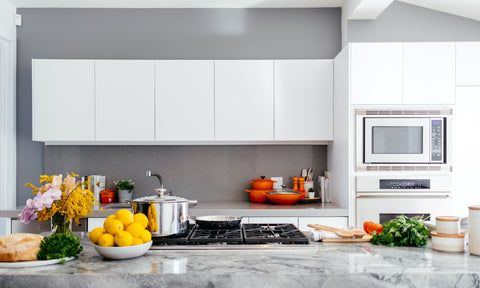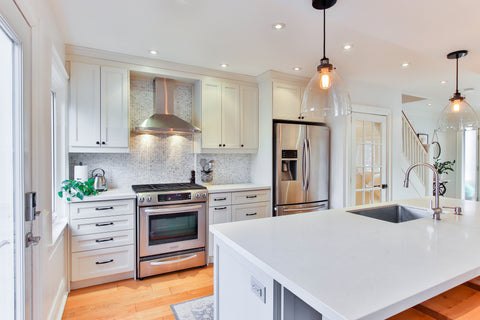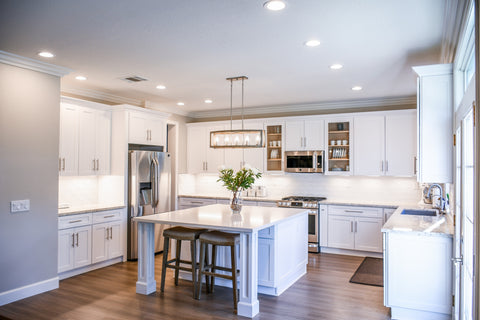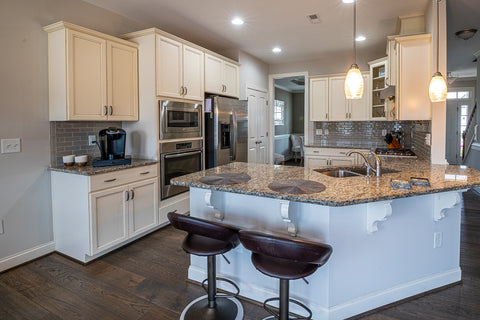Three Major Areas of a Kitchen And Different Kitchen Layouts
How do you see your kitchen? Is it a single unit for all those involved in the meal-making process? Or do you have sections defined for different tasks like washing, preparing, cooking, serving, and others? Create as many as you like, but there are three zones that combine to make the popular kitchen triangle. Want to know more details? We’ll discuss those and the best arrangement tips to make your kitchen times productive.

Photo by Jason Briscoe / Unsplash
Every kitchen needs to have separate work zones for food storage, preparation, cooking, and cleaning. The kitchen’s work triangle forms the basis of the most effective kitchen designs. However, some modern layouts focus more on easily accessible and well-managed zones like the L-shaped, U-shaped, and one-wall kitchens.
The Basics of a Kitchen Layout – The Work Triangle
Let’s begin with understanding the triangle concept we mentioned in the introduction. It’s a century-old concept that still holds prominence in designing a kitchen. It emphasizes the art of efficiently organizing the areas of food storage, preparation, and cleaning. The theory dictates placing the three elements close enough to prevent the cook from wasting time and effort while preparing meals. Even though modern kitchens include more appliances and functions, this setup still forms the basis of a functional design.
So, how far or close would be good? Here’re some ideal characteristics of a kitchen work triangle:
- Each side of the triangle should be 4 feet to 9 feet long, neither less nor more.
- The total measurement of all the sides combined should fall within the 13 to 26 feet range.
- No cabinetry or appliance should intersect any side of the triangle
- All the major traffic flow should happen outside the triangle, keeping the area free from workflow intrusion.
The Modern Approach – Kitchen Work Centers/Zones
Decades after the work triangle was introduced, several new functions and appliances have emerged today. This requires today’s kitchens to update structures to incorporate the new things in the layout. As a result, modern designs are evolved with a focus on work zones/areas rather than triangles. Each zone is used for a particular activity and is arranged to allow easy access, movement, and workflow. Wondering what those zones are? Here’s a brief introduction to the three major areas – food storage and preparation, cooking, and cleaning.
- Storage Area for Supplies: Where do you keep all your raw vegetables, bowls, dishes, small appliances, and canned/dry goods? That’s this zone. An ample clear workspace for all the meal preparation tasks starts here. However, the primary food storage should be at the countertop’s longest stretch. But that’s not its only use. A preparation area also goes beside this. Dedicated ample space for mixing ingredients, chopping vegetables, and preparing meat. And if you have big kitchen space, you can create an extra sink here for washing vegetables and food.
- Hey! Do you use a tablet or cookbook for recipes? You will need a separate space for them.

Photo by Sidekix Media / Unsplash
- The Cooking Area: This is your next stop after washing and preparing vegetables unless you like to eat them raw. This area should be directly accessible from the prep area. While ovens, cooktops, and cooking ranges dominate this area, you will also need items like pots, pans, hot pads, pot holders, and utensils for cooking purposes.
- Some items are stored in the cooking zone, like seasonings, spices, and oils. So, this means you also need storage space in the cooking area. Notably, heat-resistant surfaces and ventilation systems help keep the fumes and heat away.
- The Washing Area: Since the sink is this area’s central point, dishwashers and garbage disposal are equally important. The dishwasher and sink stay next to each other, always like true lovers, minimizing floor drips and simplifying washing utensils. The dishwasher should go to the left of the sink for the right-handed cook and vice versa. Cleaning products and dish towels also go in this area.
Now think about where you should place the utensils, glassware, and dishes you use daily. Storing them near the dishwasher saves you from extra steps while unloading. And putting them in cabinetry near the dining table reduces serving time.
The Best Kitchen Layouts – Organizing the Areas
As we’ve explained the work triangle and the kitchen work zones, let’s explore how to organize everything to make the workflow the best for you. The layout should allow unimpeded movement since you will constantly move between the three areas. You can create a custom layout or choose from the basic designs discussed here based on your kitchen’s size and functionality.
- L-shaped Kitchen Layout
Here’s a starter pack of organizing work areas for mid to small-sized kitchens. Next time you visit a friend or relative living in a studio-style apartment, you will recognize the style. The L-shaped layout incorporates units and work surfaces arranged around a corner where two perpendicular walls meet. From placing appliances to dedicated work zones, this structure offers high flexibility. Cabinets are also installed against the walls to provide the required storage space.
L-shaped Layout Design Tips: The best part of this structure is that it allows putting the corner space to use. You can use a walk-in pantry cupboard to utilize the corner while saving the rest of the space for other essentials. An L-shaped kitchen can blend well into the living room area. If you have a large area, you can add an island to add family entertainment and gathering features to the kitchen.
- U-shaped Kitchen Layout
Also known as a horseshoe layout, a U-shaped structure is ideal for small kitchens in spaces differentiated from living and dining rooms. You can create a perfect work triangle in this type of kitchen, designed with three adjoining walls forming the U-shape. This structure provides a lot of storage space, alongside a good workflow and enough room for multiple users to navigate together. However, this layout can make you feel enclosed in smaller areas if you install many cabinets and storage drawers.

Photo by Mark McCammon / Pexels
U-shaped Layout Design Tips: The best bet is to keep the space as uncluttered and open as possible. With two corners involved in the structure, you can install carousels and pull-outs to ensure no waste of space. You can also get rid of the closed-in feel in small spaces by avoiding upper cabinets on all three walls. Also, replace wall units with open shelves to get a larger and open appearance for your small kitchen. Finally, if you can include a window, it will let the natural light in for a better aura.
- One-wall Layout
Do you have a small kitchen space? And are you looking for something that makes cooking straightforward without restricting its functionality? A one-wall kitchen could be the perfect solution in such a case. It defies the work triangle norms but uses vertical space for arranging food storage, preparation, cooking, and cleaning areas. Another name for this structure is Pullman kitchen, as it comprises a cooktop, appliances, and cabinets with pull-out drawers installed against a single wall. This layout is commonly used in single bedrooms, garages, and studio apartments, where there isn’t much space for big appliances like a full-size fridge and a dishwasher.
One-wall Layout Design Tips: Think vertical and evaluate how high you can go to create accessible storage spaces. Put up some overhead cabinets and shelves to make the most of your vertical space. Further, you can add movable items like a kitchen cart or a mobile kitchen island for extra space to work and serve. You can create an easy workflow in this kitchen with a refrigerator at one end, a sink on the other, and an oven/cooktop/range in the middle. And if you have some vertical space left above the cabinets, you can use it to store items that you use the least.
- Galley Layout
Do you need an uncomplicated, simple design that uses every nook of your kitchen space? The galley kitchen is what you need if you have a snug space or a small kitchen. The lean and efficient structure comprises two cabinet walls facing each other. This justifies other names for the layout, namely parallel kitchen and corridor kitchen. In addition, it provides an inner passage between the walls for the cook to move from one kitchen zone to another. Besides, forgoing corner cabinets and lesser need for unique gadgets also add cost-effective features to this layout.
Galley Kitchen Design Tips: There’s already extra storage space and flexibility in this design with an extra cabinet row. Keeping work areas like cooktop and cleaning zones on one side only allows for a smooth traffic flow while avoiding intersections to any work triangle legs. Using a storage area on one side and cooking/cleaning on the other also helps you separate dry and wet zones, minimizing food contamination and other problems.
- Island Layout
Large kitchen spaces are gaining more hype in urban households. An island layout is one of the most sought-after structures for open-plan homes. As the name indicates, it comprises a large, freestanding (detached) countertop (referred to as an island) standing in the middle of the kitchen. In addition to access allowed from all sides, it also adds better functionality and storage to the kitchen. The most crucial benefit of this structure is the island’s versatility, as you can use it for food preparation, cooking, or washing. In addition, the center countertop can also serve as a socializing point for the family during the preparation and cooking times.
Island Layout Design Tips: The best use of having such a huge, versatile space is using it for work and entertainment in addition to kitchen chores. You can also install decorative lighting to make your area look more appealing. In addition, you can use an island countertop with cabinets on the functional front to increase the kitchen’s storage space. Create a double island layout to differentiate cooking and socializing zones for extra-large areas. Moreover, you can also get movable islands to convert to other kitchen layouts. For instance, you can create the galley layout of the one-wall kitchen or transform the L-shaped kitchen into a U-shaped one using the movable island countertop.

Photo by Curtis Adams / Pexels
- Peninsula Layout
Peninsula is a piece of land surrounded by water on three sides and connected to the ground on one side only. That’s where the idea about this layout comes from. A peninsular structure is similar to an island layout, except that the detached countertop is connected to the kitchen wall on one side. In other words, it can be referred to as an island coming out of the wall. Thus, you get your multi-purpose countertop that takes lesser floor space.
Peninsula Layout Design Tips: Like the island layout, you can use it for extra storage in your kitchen. Moreover, the countertop can be used for socializing, serving food, or as a drinks station.
Quick Tips to Organize Kitchen the Right Way
Investing in all that research and planning would all go in vain if you fail to maintain the kitchen order. So let’s check with some quick kitchen organization tips here to ensure you are doing them right.
- We’ve been talking about storage and space in almost every layout. So, you should start with going through cabinets and drawers to donate and discard things you don’t need or won’t use.
- Next, proceed with grouping similar items together. For instance, place baking items together in one cabinet and cooking items in another. You can organize and label items and drawers/cabinets for better accessibility.
- Prefer using clear containers to ensure you don’t have to open every jar to find a thing. This comes in as a savior when labels get hidden beneath other containers.
- Get some drawer dividers to convert your drawers into multi-purpose storage spaces.
- Last but not least, many people are used to keeping bills and other papers on the refrigerator top or a countertop. Hanging a magnetic sorter on the refrigerator’s side will provide an organized space for takeout menus, coupons, notepads, stationery, and other papers.
To conclude, designing a kitchen layout is something you need careful planning and knowledge. However, considering the work triangle, work zones, and personal preferences, you can create a fully functional, easy-to-navigate, handy kitchen by making slight changes from the norm.

